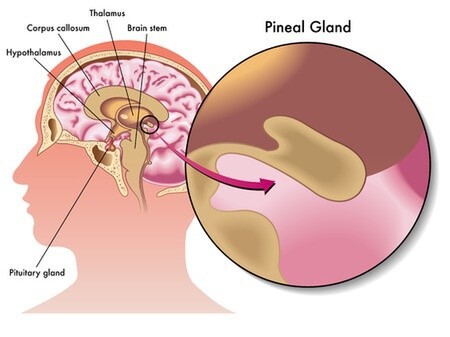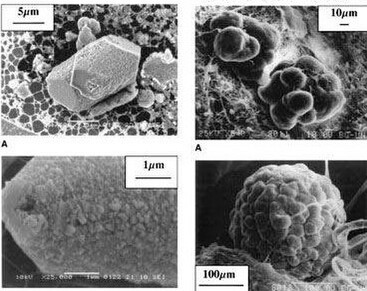By Dr. Sophie Scheffer, general practitioner
Endowed with exceptional properties by René Descartes or Hindu mythology, the pineal gland has benefited from recent scientific research which seems to corroborate these ancient intuitions. So, what does this tiny gland do?
Measuring 8 mm, the pineal gland, also known as the epiphysis, is the smallest gland in the human body. It owes its name to its conical shape similar to a tiny pinecone. Located in the middle of the brain, it plunges into the third ventricle [1].
1.The biochemical function of the pineal gland
In human beings, the pineal gland grows until the age of 2 years and then stabilizes; its mass increases again at puberty, during which time it contributes to sexual development.
It is known for the secretion of melatonin, known as the sleep hormone, responsible for controlling the rhythm of the physiological circadian cycle (biological rhythms over 24 hours). Its synthesis is regulated both by the internal circadian clock and by light from the environment. It is derived from tryptophan, which is converted to serotonin and then melatonin.
In fact, at the level of the pineal gland, melatonin is a precursor of the sleep hormone. In 1996, Dr. Jean-Bernard Fourtillan discovered that 3 hormones are secreted by the pineal gland:
- Melatonin,
- the 6-methoxy-harmatan,
- and valentonine, a real sleep hormone.
Thanks to these 3 hormones, the pineal gland regulates the sleep-wake system. The cycles of secretion of these 3 hormones produce the different sleep cycles. The pineal hormones thus inform the body about the day-night alternation, linking the body with its environment.
Their secretions start at dusk and stop at dawn, synchronizing the sleep/wake cycle and regulating the daily and seasonal rhythms of many of the body's biological functions, ensuring homeostasis, reproduction and survival.
In animals, melatonin regulates behaviour in relation to the seasons: migration, hibernation, reproduction.
We know the importance of sleep, which allows the elimination of toxins from the brain. Every cell produces energy from oxygen, glucose and minerals. It eliminates its own waste products (free radicals); it can also absorb chemicals and environmental toxins. The cell must metabolize all these elements and eliminate them. The same process is at work in brain cells (neurons, glial cells) [2].
If this waste is not eliminated sufficiently, it accumulates in the brain centres and leads to pathologies such as Alzheimer's, Parkinson's, Creutzfeldt-Jakob and other neurodegenerative diseases. Very recent research shows that the elimination of toxins is improved by
- sleep: by increasing the white matter spaces around the vessels by 50%, it promotes return circulation which eliminates waste.
- the arterial circulation: by its pulsations, it massages the brain and propels the lymph. Disturbances of this vasomotion can cause the accumulation and deposition of toxic solutes.
From the brain, melatonin is also transported via the blood to all the organs. As it easily crosses cell membranes, it is present in all the cells of the body. It protects them thanks to its powerful antioxidant power.
Melatonin is also secreted in the gastrointestinal system at much higher levels than in the pineal gland: there is ten to one hundred times more melatonin in the gastrointestinal system than in the blood and at least four hundred times more than in the pineal gland. It then acts only at the gastrointestinal level, playing an important role in the balance of this system.
It is also produced in the eye, where its action remains local.
2.The vibratory crystalline function of the pineal gland
A biomineral process affects the pineal gland, causing its calcification.
Dr. Sergio Felipe de Oliveira runs the Pineal Minds Clinic in Sao Paulo (Brazil), which he founded. While studying pineal glands under the microscope, he noticed that they revealed organized crystalline structures covered by envelopes of connective tissue. These crystalline structures are composed of concentric lamellae, like an onion. The older you are, the more lamellae there are [3]. It has been observed that blood microcirculation keeps these crystals active and alive: the pineal gland is highly vascularized, which underlines the importance of its function.
These crystals can receive electromagnetic information which they will transform into electric waves and biochemical waves called biomagnetism. In 2002, Simon Baconnier et al. studied the role of the pineal gland [4] in electromagnetic transmission [5], demonstrating its ability to transform electromagnetic waves into electric waves: this is called the piezoelectric function.
Dr. Sergio Felipe de Oliveira has also found that by capturing electromagnetic waves, crystals transform them into electrical waves, transported by neurons, which will then impact different structures in our brain: this phenomenon can condition our thoughts, emotions, hormonal system and autonomic nervous system. He explains that disruptive information (physical or emotional trauma) would lead to specific pathologies:
- in the forehead, impulsive behavior, obsessive thoughts,
- in the limbic area, depression, crying, unexplained sadness,
- in the occipital lobe, visual impression, impression of seeing inside his head (perhaps), intrusive imagination,
- in the motor cerebral cortex, motor disturbances, seizures,
- in the hypothalamus, psychobiological disorders (sexuality, hunger, aggressiveness, sleep, with loss of control over one's behaviour),
- in the pituitary gland: endocrine disorders.
Lithium is said to regulate the pineal gland. Excess fluorine, on the other hand, would block its capacity for action.
In addition, Dr. Sergio Felipe de Oliveira has shown that each crystal of the pineal gland develops from a mitochondrion. A former bacterium that has integrated into a living cell, the mitochondrion has its own DNA, outside the cell nucleus which contains human DNA.
Mitochondrial DNA (mtDNA) is a small circular DNA molecule containing 37 genes that code for 13 proteins essential for the cellular respiratory chain and energy production. Research on mitochondrial DNA has made it possible to select the origins of human groups going back as far as 150,000 years (African origin).
The consequences of biomagnetic function
The crystals give the pineal gland a structure similar to that of a sound box. The more crystals a person has, the more possibilities he or she has to pick up electromagnetic waves. The number of crystals seems to be a biological characteristic, just like eye or hair colour.
- As Simon Braconnier et al. assumed, the surrounding electromagnetic waves (GSM, wifi, computers...) can impact the pineal gland. Could this allow us to understand the disturbances linked to these man-made waves? Could it explain how people become electro-hyper-sensitive (EHS) but also why this occurs form some people and not others (greater number of crystals)?
- According to Sergio Felipe de Oliveira, the pineal gland is so sensitive to magnetic fields that we could explain the mechanism of the relationship between the Higher Self - the mind - and thought, but also how the person's Higher Self, the "Mind", communicates with all the functions of the brain, as well as with all the physiological systems of the human body. Our brain is like a hardware that needs software to communicate with the Higher Self, the programmer that acts beyond our brain.
I relate this vision to that expressed during the symposium on The Consciousness and the Invisible that took place in Paris in February 2017. The speakers, Dr. Raymond Moody, Dr. Eben Alexander and Dr. Jean-Jacques Charbonnier discussed near-death experiences. They expressed that our consciousness is not localized in our brain. Indeed, people who live NDEs are clinically dead for a few moments, but their consciousness is then very much alive: for example, they see that doctors are trying to resuscitate them, their consciousness being then "outside" their body. It is close to Descartes' assertion: the pineal gland would allow the connection between the soul and the body or between the consciousness and the body.
- Through the pineal gland, one could understand clairvoyancy. Clairvoyants seem to receive information from another dimension where past, present and future coexist. According to Sergio Felipe de Oliveira, "the pineal gland is a sensory organ of mediumnity, similar to a mobile phone that picks up waves of the electromagnetic spectrum coming from the spiritual dimension, the frontal lobe making a critical judgment of the message with the help of the other encephalic zones.”
In conclusion, the pineal gland is essential for the human being
- It has a chronobiological activity: it regulates the circadian rhythm (day/night).
- Its different hormones regulate the different phases of sleep. Sleep is fundamental in the balance of the body and the psyche; it also allows the elimination of toxins from the brain: we could speak of a preventive action in the development of neurodegenerative diseases. Melatonin has a very powerful protective antioxidant action: in the brain, peripheral tissues via the blood, in the intestines and retina.
- Diving into the third ventricle of the brain, which contains cerebrospinal fluid (CSF), the pineal gland is constantly aware of the pressure of this fluid in the brain. It can react to a change in pressure, for example, following trauma.
- The pineal gland is a receptive structure for electromagnetic waves (cerebral, environmental, cosmic). It converts them into electrical waves, which are then broken down into cerebral and endocrine neurochemistry. This capacity is called "biomagnetism". It would thus orchestrate internal and external electromagnetic information.
- One could mention the possibility of storing ancestral information since the pineal gland comes from mitochondria that contain information-rich DNA dating back 150,000 years.
- It is considered sacred in many ancient traditions: the seat of telepathy, of contact with Knowledge, of the soul. It could allow us to understand the phenomenon of clairvoyancy, in the broadest sense: extra-sensory perceptions, intuition...
About Dr. Sophie Scheffer
A general practitioner graduated from the Faculty of Medicine in Reims, with a degree in homeopathic medicine from the Belgian School of Homeopathy, Dr. Sophie Scheffer has been practicing for 20 years in Belgium where she combines general medicine, homeopathy, nutrition and phytotherapy. She created the Epidaure Integrative Medicine Centre. Her approach is multiple because her vision is the complexity of the human being, often requiring complementary medicine in a network of practitioners to provide access to healing.
Other article by Dr Sophie Scheffer
Homeopathy in oncology: a contribution to the quality of life and patient healing
Footnotes
[1] Ventricles are cavities in the brain containing cerebrospinal fluid, which is then transported to the spine.
[2]
- Comment le cerveau évacue ses déchets, Revue Pour la Science n°467. Neurobiologie. M. Nedergaart, S.A. Goldman, sept 2016.
- The glymphatic system: a begginer’s guide 2015 N.A. Jessen, et al. vol 40, pp 2583-2599.
- Regulation of cerebral spinal fluid flow in neurodegenerative, neuvascular and neuroinflammatory desease M.J. Simon, J.J. LIiff, 2015, Biochemica et Biophysica Acta -Molecular Basis of Disease.
[3] Pineal Gland Volume Assessed by MRI and its Correlation with 6-Sulfatoxymelatonin Levels among Older Men, J Biol Rhythms. 2016 Oct; 31 (5): 461–469. Lara G. Sigurdardottir, PhD and al.
[4] Calcite microcrystals in the pineal gland of the human brain: first physical and chemical studies, Simon Baconnier, Sydney B. Lang, Maria Polomska, Bozena Hilczer, Institute of Molecular Physics, Polish Academy of Sciences, Poznan, Poland, Bioelectromagnetics Volume 23, Issue 7, pages 488-495 October 2002. First published: 10 September 2002.
[5] New Crystal in the Pineal Gland: Characterization and Potential Role in Electromechano-Transduction Baconnier Simon, Lang Sidney B., De Seze Rene (3) (1) DRC, Toxicologie Expérimentale, INERIS, 60550 Verneuil-en-Halatte, France, August 2002.


